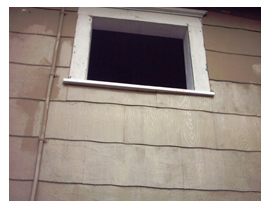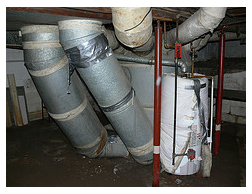What You Need to Know About Asbestos
What Is Asbestos?
Asbestos is a grouping of six fibrous minerals that are natural in occurrence. It is milled and mined from rock and is strong and thin. It may be found in most countries worldwide, but most comes from Canada, the former Soviet Union, South Africa, and Australia.
How Is Asbestos Used?
It is estimated that as many as 3,000 different varieties of commercial goods contain asbestos. In homes built before 1978, asbestos is often found as a form of thermal insulation on pipes and boilers. Additionally, it can be found in a number of other household materials, including:
- Vinyl floor tiles (usually 9" x 9" tiles contain asbestos, but all tiles ought to be tested to be sure)
- Glue that is used to attach floor tiles to wood or concrete (also known as "mastic")
- Some types of linoleum
- Plaster
- Window glazing or caulking
- Siding material
- Roofing materials
- Fiber cement siding (usually 1/8" thick and 8' x 4', brittle)
- Heavy duty corrugated panels
- HVAC duct insulation (usually found in corrugated or flat paper form)
Asbestos appeals to builders and manufacturers for numerous reasons. Both heat and chemical resistant, asbestos does not corrode. It also performs well as an insulator. Its flexibility makes it easily woven and quite useful in a variety of industrial applications. There are very few materials used in manufacturing that possess all of these qualities, making asbestos a very popular choice in chemical, thermal, and fire-resistant applications.
What Are the Risks Associated with Asbestos?
Asbestos, when it becomes damaged, can release fibers into the air. If asbestos becomes airborne, inhalation may result.
These fibers in floor tiles, laboratory desktops, sidings, etc., are tightly bound into the other materials in these products; therefore, asbestos fibers are not easily released. However, if the asbestos is sanded, sawed, or abraded, the material can be easily rendered friable, causing the fibers to become airborne.
Inhaled asbestos fibers become trapped in the lungs, where they cause scarring and inflammation that can eventually lead to substantial health problems. Asbestos is a known carcinogen that has been associated with lung cancer, mesothelioma, and other forms of cancer. It can also cause various nonmalignant lung diseases.
Children are particularly susceptible to asbestos-related disease. The normal period of latency for an asbestos-related disease in adults can be anywhere from 20 to 50 years following the exposure. However, among children, the latency period can be much shorter, striking them with illness very early in life.
How Can I Protect My Health?
Do not sand, cut, or break any asbestos-containing materials, or ACM. The materials will release fibers if they are disturbed in this way, even if they are non-friable.
If, for some reason, you are required to work in an area where there may be a presence of asbestos dust, use a garden sprayer to wet the area thoroughly, or use a regular spray bottle of water with a few added drops of dishwashing detergent. A detergent will keep the fibers from becoming airborne by reducing the water's surface tension and allowing it to more readily penetrate the asbestos fibers. Immediately dispose of all rags used to remove the ACM dust.
If, for some reason, you are required to work in an area where there may be a presence of asbestos dust, use a garden sprayer to wet the area thoroughly, or use a regular spray bottle of water with a few added drops of dishwashing detergent. A detergent will keep the fibers from becoming airborne by reducing the water's surface tension and allowing it to more readily penetrate the asbestos fibers. Immediately dispose of all rags used to remove the ACM dust.
Do I Have to Remove All Asbestos From My Home?
There presently exist no federal or state laws that require the removal asbestos from your home simply for the sake of being rid of it.
 Floor tiles, roofing, and siding containing asbestos are very strong and do not crumble readily, nor do they release asbestos fibers unless subjected to strong forces. Therefore, it may not be necessary to remove these materials.
Floor tiles, roofing, and siding containing asbestos are very strong and do not crumble readily, nor do they release asbestos fibers unless subjected to strong forces. Therefore, it may not be necessary to remove these materials.
Other ACM such as boiler lagging, pipe insulation, asbestos-containing thermal insulation (e.g., batt or blown-in insulation) can be identified during inspection and analysis when performed by a qualified professional. If asbestos is found in such materials, it is advisable to seek the assistance of a consultant to help determine what should be done to remedy the situation. If these materials are not disturbed, it is possible that they may be left alone. However, if you believe that a necessary renovation or repair may disturb the ACM, you and your consultant might want to begin planning for the removal of the asbestos prior to the beginning of the renovations.
If you know, or even suspect, that asbestos is present in your home, check it periodically for abrasions, tears, breakage, or water damage. If you discover slightly damaged material, limit access to the area and do not touch or disturb it. In the event that the asbestos material appears more than slightly damaged, or if you are planning to make alterations in your home that might result in its disturbance, professional removal is needed.
Asbestos removal is not a do-it-yourself project. Professional removal is required.
Why Do I Need a Professional and How Do I Find a Qualified One?
If asbestos is improperly removed, your home can suffer serious contamination. Professional cleanup of the contaminated areas could prove more costly than if professionals had originally performed the abatement.
Because asbestos fibers can be too tiny for the eye to detect, professional contractors use specialized confinement techniques and cleaning equipment in order to contain and remove asbestos materials and fibers.
Asbestos is difficult to control without the proper equipment. Special equipment has been designed for abating asbestos properly. This equipment must be used and cleaned in a proper manner to ensure that little or no exposure to asbestos fibers occurs during or after abatement.
Once the process is complete, air samples need to be taken in order to guarantee that no asbestos fibers remain.
NJ requires all ACM abatement contractors to have a NJ Dept. of Labor & Workplace Development license. Additionally, all of the contractor's employees who take part in conducting the abatement must possess a Department of Labor and Workforce Development (DOLWD) supervisor or worker permit.
To ensure that the contractor you are hiring will do a satisfactory and safe job, you might want to take the following steps:
- Telephone the NJ DOLWD at (609) 633-2158 to ascertain that the contractor is reputable and licensed.
- Ask the contractor about his/her abatement experience and request references from projects similar to yours.
- Obtain a thoroughly detailed estimate of the services that are to be provided, including monitoring, replacement, design, damages, etc.
- Inquire about the contractor's liability insurance (the type, the amount, and what it covers).
- Obtain four estimates-they may vary significantly. Be sure that all estimates are for the same, exact job specifications.
- Talk to each contractor to learn precisely what he or she will do for you. Hire one based on your overall evaluation of services and your comfort level with the contractor, not just the cost.
- Consider hiring a monitoring firm that has no financial relationship with the abatement contractor to oversee the removal. Projects with a monitoring firm are generally done better, but can be more costly.
- Inform yourself about what transpires in an asbestos abatement so you will know what to expect and can fully understand what actions must take place.
Want to Know More?
For more information about asbestos and related diseases from the National Cancer Institute: http://www.cancer.gov/cancertopics/factsheet/Risk/asbestos
For more information on siding that contains asbestos:
New Jersey Department of Heath Asbestos Resource
For more information on pipe insulation that contains asbestos:
Environmental Protection Agency Asbestos Resource
